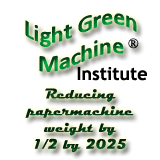 |
19 Feb 14: Computerization 3: Amazon Flow
|

OK, now the innovations are coming so fast we can barely keep up with them. As we were going to press last week with our discussion about Google Glass, Amazon was introducing "Amazon Flow." This is an app that, for the moment, can recognize consumer goods and take action upon the recognition. Its use at the moment is to recognize items in your pantry or refrigerator and put them on your grocery shopping list with Amazon. It is purportedly faster than reading bar codes.
And, like we said last week about Google Glass, it is just a matter of algorithms to make Amazon Flow recognize other things, such as comparing today's fourdrinier table to what it is supposed to look like under ideal conditions.
In ten years, you won't recognize paper making, folks.
Any comments? Let us know by sending an email to jthompson@taii.com with "LGMI Frontiers" in the subject line.
The old topic of fabric press hoods brought out the commenters last week: Jim, Fabric hoods should be a very workable alternative. The idea of a rapid roll-up system like has been used for weather enclosures in such things as rail car unloading facilities should be very applicable. If damaged, replacement could be quick and cheap. Taken to the extreme, what about a 2-layer hood fabric designed to be inflated to come to the proper shape for the hood and to give clearance to the machine. Framing needed for support would be minimal, needing only to support the weight of the fabric when the inflation air is removed so the hood could be folded to provide total access to a section of the machine. The roof over the Hubert Humphrey Dome is an example of this kind of system. There are several more of these systems used as football practice field covers and such. Good idea. Ed Turner Camden, North Carolina ---- Jim, The main issue I would have with fabric hoods would be insulation value and whether we would need to increase hood exhaust flows to prevent sweating and condensation within the hood. A good closed, insulated hood requires much less air flow than an open hood. I'm afraid a fabric hood would head us back in the other direction. Best regards, Jeff Reese International Paper Loveland, Ohio
----
Jim, while modern fabrics can support the transmission of air, e.g., flexible fabric duct sections, they cannot readily "hold" the water or heat that is released in the drying process. The cheap tarps (and even expensive ones) degrade over time and must be periodically replaced. After several replacements, most folk realize that they should have made the proper investment investment in a false ceiling (or better yet revisited their showering process and put in an effective mist collection system) as the labor to replace the tarp and the associated aggravation far exceed one time investment. The hood is only one component of an effective dryer section ventilation system. Remember that on a mass basis the amount of air required for making paper exponentially exceeds the amount of water or fiber. Better make good decisions so you can control the cost of removing and/or heating that air. Another thought...tarps have their good uses but you wouldn't use one for storing your hot rod or pleasure boat that you invested plenty of your hard-earned money on would you?
Mark Harrison Application Specialist at Metso Paper
----
Well Jim, it is an interesting question but there are many answers to it. Like you say it can be done temporarily. However there are many instances when you have to "climb" on hoods, tighten the hoods for airflows, minimize the heat losses and these restrictions demands more robust light weight materials. Then to use some more robust light weight materials of modern materials are also doable but also needs to be cost effective if you thin for instance carbon fibre. I will pass your comment internally.
Managing Director (and General Sales Manager) at Valmet UK Ltd
----
 LGMI DESIGN PRACTICES ARE NOW AVAILABLE! |
|
|
As always, your comments will be appreciated.
|
|
Think light!
Brian Brogdon, Ph.D.
Executive Director
or
Jim Thompson
Founder
Send us your comments by emailing Brian Brogdon
or Jim Thompson!
|